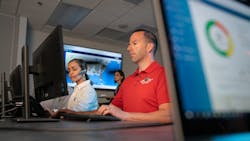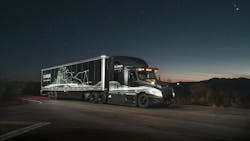Navistar CEO opens up about company technology roadmap, Traton merger
During a February 4 media roundtable discussion, Mathias Carlbaum, Navistar president and CEO, went on to say that 2022 will be a “very decisive” year for Navistar, where the company will set some of the parameters for the future, while working with Traton on technology developments.
Carlbaum took over as Navistar’s president and CEO in September 2021, succeeding Persio Lisboa. Carlbaum was previously EVP of commercial operations at Scania CV AB, and since April 2021, he led post-merger management of Navistar on behalf of the Traton Group.
And welcome news for the American market—Carlbaum anticipates that toward the end of the year, operational challenges will gradually normalize in terms of supply.
“It's truly the moment now, when we, as a global organization, as a player in North America, can really drive the transformation in the sector towards clean technology—and data driven,” he said.
The future of predictive maintenance
The “data driven” operations Carlbaum mentioned allude to realization of predictive maintenance, where the flow and leverage of data generated from a vehicle can be integrated into a fleet’s maintenance and management practices.
For Carlbaum, “uptime is the currency” when it comes to fleet maintenance. With that in mind, Navistar sees continued opportunities for more predictive maintenance practices, where fleets and dealers rely on vehicle data, artificial intelligence, and sensors to improve uptime.
Navistar’s OnCommand Connection Advanced Remote Diagnostic solutions are available on all International commercial trucks, diesel engines, and IC Bus school and commercial buses. The end goal is for fleets and dealers to incorporate data from logistics systems to maintenance systems.
“The interface that we offer is quite seamless, but the data from the vehicle is useful for our development process,” Carlbaum said. “I see huge opportunities in this area of predictive maintenance and predictive repairs. Some of it based on AI, some of it based on sensors, but the data that we get from vehicles today is key. It gives us this possibility of predictive maintenance, avoiding, of course, not only taking the vehicle off the road, but also the ability to do the right maintenance and bundle the different parts at the right time.”
He added that the “preparedness of the data” also enables dealerships to be faster and more prepared to have the right parts and technicians in place, so fleets can better plan stops.
“I always like to think of it as a form of a pit stop where nothing is unexpected,” Carlbaum said. “So, you actually work with data to drive predictive planning, so that the customer can stop less. And when [the customer] is stopped, the flow through time is much shorter.”Fleet demand for uptime will be even more critical as future technologies emerge and advance, Carlbaum added.
“The battery vehicle has to work, and over time as we go to autonomous, it’s 24/7; unplanned doesn't exist,” he advised. “Everything shall be planned, and our organization shall be there with data to give the right service to the customer without surprises. So, over-the-air software enhancements and all of that needs to be driven over data.”
Electric lessons learned
Electric trucks and what they mean for the continued development of diesel and internal combustion engines have executives in the Navistar boardroom scratching their heads every day, according to Carlbaum.
Electrification is a buzzword at the fore of many conversations today, but the reality is fleet investments in ICE—with a growing focus on efficiency and lowering emissions—remain strong. Proof of that is Navistar’s recently released updates to the International A26 engine, touted to help fleets achieve 10% improved fuel economy. Updates like this are part of the OEM’s overall intent to drive incremental changes that forge a path toward decarbonization, efficiency, and, ultimately, total cost of ownership for fleets.
“All the decisions we are making today are truly to pave our future as a zero-carbon emitting company and that our products, no later than 2040, in the full chain of the value proposition of Navistar will be zero carbon,” Carlbaum pointed out.
As for electric trucks, depending on what segment fleets are operating in, Carlbaum projects that the TCO case for customers will come sooner than expected.
“About the timeframe of 2027 to 2028, we do see the real tipping point for long-haul technology, batteries, infrastructure, charging, and all of this comes together,” he explained. “We will be gradually introducing it, but the real lever comes when the TCO case is so evident.”
For electric trucks today, there are certain applications and routes that are viable. Most fleets testing the technology have started out on a smaller scale to acclimate to the technology before it comes down the pike at scale.
Carlbaum explained that while the technology is still in its infancy, the right application needs to be driven by subsidies and incentives to get started. Over time, for electric powertrains to be a viable option for the long-haul segment, a battery range of some 450 miles with roughly one megawatt of battery capacity is needed, he noted. Carlbaum anticipates that will take about three to four years.
“On top of that, you need the mega chargers, which we see coming around the end of 2024 to 2025,” he advised, adding that vehicles need at least five hours of drive time and a recharge period of 30 to 45 minutes. “That's when it starts making sense over the longer routes.”
As for hydrogen technology, Carlbaum said Navistar does believe there is a use case today. However, because there is less energy efficiency in hydrogen compared to battery-electric technology, once battery technology catches up, the hydrogen use case will be closed over time, he said.“I cannot say the time when that will be applicable, but there is a window there,” Carlbaum added. “As battery tech moves forward in the mid-2030s, this will catch up. We strongly believe that the overall long-term solution basically given the basics of energy efficient storage of batteries will prevail when the technology is proven enough.”
Until these technologies are proven in the linehaul segment, Navistar is not expected to release a Class 8 electric truck offering.
“Regional could come up earlier, of course, but not long-haul Class 8,” Carlbaum explained. “When it really becomes relevant—the business case and the application, the battery capacity, the charging, the infrastructure and mega capacity the charging station has—then we will have a product here.”
Right now, Navistar is showcasing its battery-electric journey in other areas—mainly medium-duty with the International eMV Series, in the school bus segment, and regional when the time comes.
Brand legacy, moving forward
Moving ahead, Carlbaum pointed out that Navistar’s 200 years of history mixed with Traton’s “forward-leaning technology and experiences from other markets is a very good combination.”
The OEM expects that future technology, like autonomous trucks, will come to the U.S. rapidly compared to other markets.
“We do clearly see that autonomous is going to be first out here in North America, perhaps at the same time we see it happening in China,” Carlbaum said. “But for us, as a group, we must be very forward leaning into what's happening with autonomous technology here.”
He pointed to Navistar’s partnership with TuSimple and already having vehicles running in autonomous mode.To read the original, full-length article—click here.







